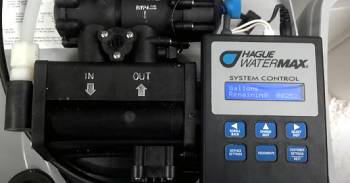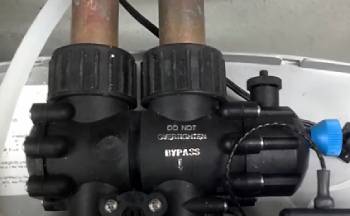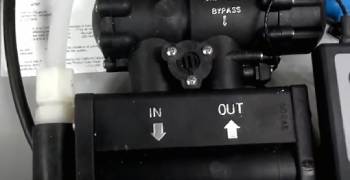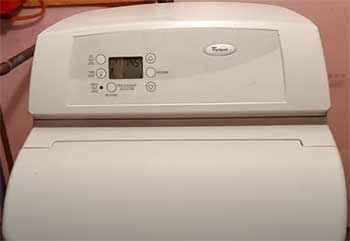If you’re looking to invest in a water softener, the Hague system might’ve landed on your radar.
I’ve used the Hague WaterMax, tested its features, and combed through actual feedback and personal experience—and in this review, I’ll walk you through everything you should know before you hit that “buy” button.
My goal isn’t to convince you to buy Hague, but rather help you understand whether it’s the right fit for your home.
Hague WaterMax Vs. Other Softener Brands – A Quick Comparison
| Feature | Hague WaterMax | Culligan Medallist | WaterBoss 900 | Whirlpool WHES40E | NuvoH2O Manor+ | SpringWell SS1 |
| Softening Method | Ion exchange + filtering | Ion exchange | Compact ion exchange | Salt-based | Salt-free citrus-based | Salt-based |
| Maintenance Frequency | Moderate to high | Moderate | Low | Low to moderate | Very low | Low |
| Installation Complexity | Requires pro help | Dealer-only | DIY-friendly | DIY-friendly | DIY-friendly | DIY-friendly |
| Lifespan | 10–15 years | 10–15 years | 8–12 years | 8–10 years | 5–7 years | 10–12 years |
| Price Range | $$$$ | $$$$ | $$ | $ | $$$ | $$$ |
| Special Features | Multi-layer filtering | Dealer servicing | Compact design | Demand initiated regen | Retains healthy minerals | High flow rate |
My Real Experience with the Hague WaterMax

I remember when I first saw the Hague WaterMax—it looked sleek, promised an all-in-one solution, and came highly recommended by a local dealer.
I live in a region with extremely hard water. So, I figured I’d go with something that could tackle both softening and filtration in one system.
Installation was handled professionally, and I was initially impressed. The softener started reducing hardness in the water almost immediately.
Within the first week, I noticed less soap scum in the shower, and even my hair felt smoother after a wash. Laundry came out softer too.
But the honeymoon phase didn’t last long.
By the third month, I had to call in a technician because the unit was regenerating more often than it should.
The settings seemed off, and navigating the control panel wasn’t intuitive. Over the next year, I had at least two service calls—not exactly what I expected from a premium-priced softener.
The final straw was the resin tank issue that popped up around the 18-month mark.
The technician explained that while the system has some unique perks, such as layered media and custom programming, it also tends to require specialized service—meaning more cost and hassle if something goes wrong. And unfortunately, it did.
Now, I won’t say the system didn’t work. It did. But the consistency and reliability left much to be desired, especially for the price I paid.
I’ve since moved on to another brand, but the experience taught me how much research truly matters before buying a water softener.
Maintenance Tips That’ll Save You Money and Stress

Smart Care for Your Hague Water Softener:
- Schedule Annual Check-Ups: Even if everything seems fine, have a technician review the system annually. It’ll cost less than a major repair later.
- Use High-Quality Salt: Always use evaporated salt pellets to reduce bridging and buildup in the brine tank. Avoid rock salt—it’s cheaper but dirtier.
- Watch the Resin Tank: If your water suddenly gets harder, your resin may be fouled. Flushing the tank or replacing media might be necessary.
- Clean the Nozzles Regularly: Remove any iron or sediment deposits in the injector and screen. This step alone can keep your system running efficiently.
- Monitor Water Usage Changes: If your household size shifts (guests, new baby, etc.), update the settings accordingly to avoid over- or under-regeneration.
- Replace Filters On Time: If your unit has a carbon or sediment filter, don’t wait too long to replace it. Doing this on schedule protects your appliances and improves taste.
- Power Clean Feature: If available on your model, use the “Power Clean” cycle monthly. It helps flush the system and extend resin bed life.
Pros and Cons of Hague Water Softeners

Pros:
- Step 1: Comprehensive All-in-One Design
Hague WaterMax combines softening, filtering, and cleaning all in one unit. That’s a big convenience if you want fewer devices in your utility room. - Step 2: Custom Programmable Settings
You can adjust the regeneration cycle and efficiency based on your water use, giving you better control—if you know how to use it. - Step 3: Advanced Resin and Media Bed
Their resin tank includes multiple layers of filtering media, which means better performance in some homes with iron or chlorine in the water. - Step 4: NSF Certified Components
You’ll find peace of mind in knowing Hague uses certified, industry-standard parts that meet safety guidelines. - Step 5: Reduced Water Waste (Claimed)
In theory, their regeneration system is more efficient, saving water compared to older softeners.
Cons:
- Step 1: Expensive Upfront Cost
You’re going to pay more for Hague. And it doesn’t just stop at the unit—installation and service are steep too. - Step 2: Dealer-Only Purchase and Service
You can’t just buy this at a big box store. You have to go through a dealer, which limits price transparency and support. - Step 3: Confusing Controls
While custom programming sounds great, the user interface isn’t beginner-friendly and often requires technician help. - Step 4: Repairs Aren’t Cheap
If anything breaks, be ready to shell out. Replacement parts are proprietary and may not be stocked locally. - Step 5: Not for Every Water Type
Despite its “one-size-fits-all” marketing, I found it underperforms in certain well water conditions unless paired with additional systems.
Hague Vs. Other Brands
- Hague Vs. Culligan

When I compare Hague with Culligan, I notice both target premium buyers. But Culligan has the upper hand when it comes to service reach and user experience. While Hague requires a dealer for installation and repair, Culligan has dedicated customer service that covers more regions and offers slightly more responsive support.
Their Medallist series is known for consistent performance. That said, Culligan often locks you into service contracts which might feel restrictive, while Hague gives you a bit more independence—if you’re tech-savvy. Still, if ease of use and after-sale service matter more, I’d lean toward Culligan.
- Hague Vs WaterBoss
WaterBoss systems are far more compact and affordable than Hague. That was one of my biggest regrets: paying four times more when a smaller, simpler WaterBoss could have done the job. WaterBoss 900, in particular, works well for medium-sized homes and doesn’t need the same level of technical service.
Sure, you sacrifice the layered media design and high-end filters, but if your goal is just to reduce hard water and protect appliances, WaterBoss gives you great value. Hague might offer longer lifespan and more precision, but the cost-to-performance ratio isn’t always justifiable.
- Hague Vs. Whirlpool

Whirlpool water softeners are usually found in large hardware stores and can be installed DIY-style. If you’re handy and want a no-frills solution, Whirlpool models like WHES40E offer dependable results at a fraction of Hague’s price.
You don’t get the same water-saving tech or layered filters, but you also don’t deal with expensive dealer service or parts. My friend installed a Whirlpool softener himself and had zero issues for over two years. That alone made me question if Hague’s complexity is worth it for most households.
- Hague Vs. NuvoH2O
This comparison is interesting because NuvoH2O doesn’t actually “soften” water in the traditional sense. Instead, it conditions it using a citric acid cartridge that prevents scaling. I tested a NuvoH2O system in my vacation cabin, and it worked well for light water usage.
The biggest win? No salt, no electricity, and almost no maintenance. But if you rely on softened water for skincare or laundry, Hague still offers actual ion exchange. You just have to be okay with the price and upkeep.
- Hague Vs. SpringWell
SpringWell SS1 is a solid salt-based softener that I also considered when replacing my Hague.
It offers high flow rates, digital controls, and comes with everything needed for DIY install.
Unlike Hague, SpringWell gives you transparent pricing and lifetime warranties on tanks and valves.
Honestly, it feels like you’re getting more for your money. While it lacks some of Hague’s filter layering, SpringWell’s simplicity and customer-friendly policies make it an attractive alternative. If I had to pick again, SpringWell would likely be my first choice.
Frequently Asked Questions (FAQs)
It depends on your needs. For premium performance and service, Culligan and SpringWell are strong contenders. For affordability, WaterBoss and Whirlpool shine.
Typically between 10 to 15 years with proper maintenance.
They are manufactured in the United States.
Prices vary by dealer, but the system often starts above $3,000 including installation.
Final Thoughts
If I’m being completely honest, I wouldn’t recommend the Hague system unless you’re absolutely committed to having a high-end water softener and don’t mind dealer-only access and ongoing service costs.
You might appreciate its multi-layered filtration and programmable features, but you’ll also have to deal with a high price tag and some potential headaches down the line.
You deserve a water softener that fits your home, your budget, and your lifestyle without causing stress—and in my experience, Hague didn’t quite deliver that.
